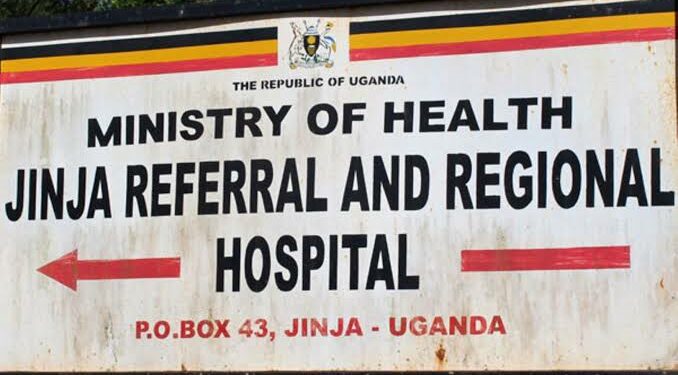JINJA Regional Referral Hospital (JRRH) has finally constructed a new modern water-borne incinerator that is only waiting for the National Environment Management Authority (NEMA) for approval and eventual commissioning by the Ministry of Health.
The Hospital Director Dr Alfred Yayi describes this development as a sigh of relief which is going to enhance health service delivery in the biggest hospital in the region that serves the 11 administrative units that form the traditional Busoga.
They are Jinja City, Jinja district, Iganga, Bugiri, Bugweri, Buyende, Mayuge, Luuka, Namayingo, Namutumba, and Kaliro.
“…with funding from the USAID, we now have a new incinerator which uses new technology and we are only waiting for the Ministry of health to come and commission it after clearance…” Dr Alfred Yayi said.
JRRH has for many years been with a non-functional incinerator, prompting the management to always use incinerator services from neighboring health facilities especially Iganga General Hospital, commonly known as Nakavule hospital.
Dr Yayi says the hospital partnered with Green Label Services, one of wastes handlers licensed by the NEMA in the count to handle hospital wastes in a professional and safe manner.
According to the NEMA website, Green Label Services based at Madigandire village, Bulowooza Parish, Bulamagi Sub County in Iganga district is one of the 156 companies licensed to handle wastes in the country.
The soft-spoken senior medical officer also disclosed that the mortuary that had taken more than 20 years without touching any paint has finally got a facelift, courtesy of A-Plus Funeral Management Company.
“…they donated 24M/= which we are using now to renovate the building including plumbing and electrical installations as well as the non functional three fridge with nine chambers…”, he said, adding management is looking for more partners to work with the hospital on how to further improve the mortuary.
Dr Alfred Yayi also says the hospital is already implementing the Busoga Local Maternity and Neonatal Services Systems (LMNS), a new strategy initiated by the Ministry of Health to save mothers and children.
He says the strategy whose role is to coordinate efforts focused at saving the lives of mothers and babies has already made positive impact in the Busoga region.
‘…these include making sure the obstetric services are there, blood transfusion services are available, emergency medicine and health services are available to save the mothers and babies…”,he said.
Other aspects include equipment and referral system, capacity building and support supervision which are being executed successfully in all the health facilities in the region of more than four million people.
The Hospital says Dr Aggrey Bameka the Medical Superintendent Buwenge General Hospital as the chairman of the strategy while obstetrician consultant Dr Joseph Woira of Jinja Hospital is the vice chairman.
He says since they have created a platform for this strategy where they review maternal prenatal deaths reports and they follow up the audit issues since this strategy started.
“…the efforts are already yielding results, for example in case of an emergency, instead of bringing the mother to the hospital we take the blood to the lower unit which saves lives and time…”, he said.
The LMNS is a partnership of stakeholders involved in maternity and neonatal services, working together to improve services, make them safer, more personal and kinder to people who use them.
Dr Alfred Yayi pointed out that JRRH requires about 10 billion Uganda shillings to revamp its infrastructural facilities currently in not so good states inhibiting the health workers from executing their roles of service delivery.
He says the hospital does not have a perimeter security fencing which makes it very difficult to manage and control intruders and errant workers from abusing the facility.
The hospital budget is 1.3Bn/annually yet medicine and health supplies alone swallow 4Bn/= meaning it suffers from a huge funding gap of 2.7Bn/=,implying the medicine supplied by the National Medical Stores(NMS) does not last even one month, hence the public chorus There Is No Medicine in the Hospital.
Dr Alfred Yayi says the old chain link continues to be vandalized by wrong elements creating illegal entry/exit points which are sometimes used to steal and vandalize facilities.
What You Need to Know:
Incinerators are used to safely dispose of solid, liquid, and gaseous wastes that result from manufacturing processes, waster of hospitals, clinics, industries, among others.
Incineration is an environmentally and technically superior method of waste disposal entertaining reliability, safety and efficiency.
Medical waste incineration is the process of burning specific wastes, including pathological, trace chemotherapy and non hazardous pharmaceutical wastes as it is considered the most effective means of treatment and prevents harm to the environment and public health in general.
While there are alternatives to incineration including autoclaving (decontamination or disinfection), chemical treatments, or ozone disinfection, experts say these technologies are incapable of completely destroying certain medical wastes, such as pharmaceuticals and specific pathological wastes.
Jinja Regional Referral was established in the 1930s as a health unit for World War II combatants and prisoners of war from Kimaka.
According to information available, in the course of time, the unit was upgraded to a district hospital and eventually into a Regional Referral Hospital for eastern region in 1995.
Annexed to Jinja Hospital is the Children’s Hospital in Nalufenya which was formerly a pub for the Asian community in Jinja who could drink until late at night and spend the night at the opposite Crested Crane Hotel.
It has a 500-bed capacity but with increased population in the large catchment areas, the number of patients usually threaten 1,000 including children at Nalufenya Hospital.
It serves as a referral for six general hospitals both private not for profit (PNFP) and a number of private for profit (PFP) within the region. The hospital serves 22 health centre IVs, namely: Budondo, Bugembe, Bugono, Bumanya, Kaliro, Buwenge, Busesa, Buyinja, Kidera, Mayuge, Kigandalo, Kityerera, Kiyunga, Malongo, Nakasongola, Mpumudde, Walukuba, Namwendwa, Nanaknduli, Nankoma, Ngando and Nsinze.
Jinja Hospital is designated as an Internship Centre where graduates of Ugandan medical schools can undergo a year of internship under the supervision of consultants and specialists in the designated medical and surgical disciplines.
Do you have a story in your community or an opinion to share with us: Email us at editorial@watchdoguganda.com













